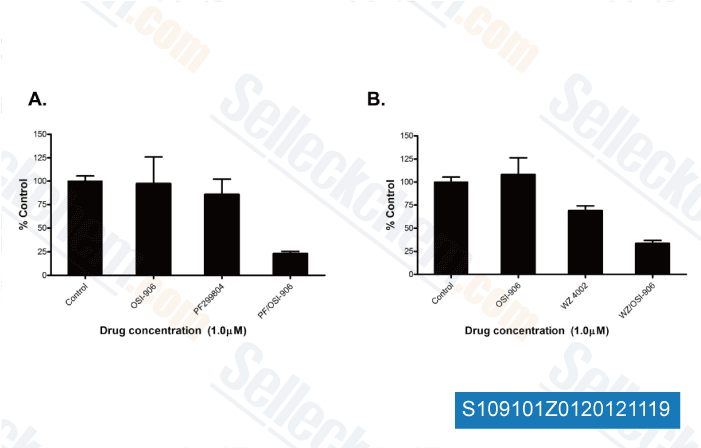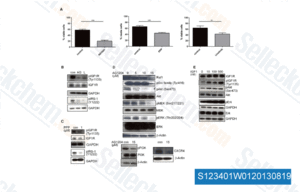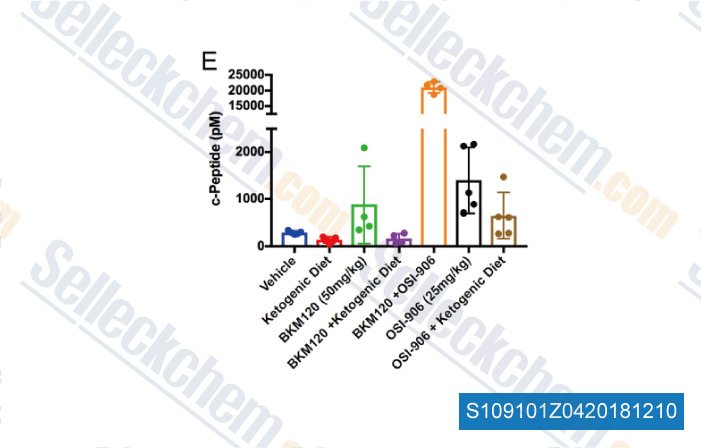|
Toll Free: (877) 796-6397 -- USA and Canada only -- |
Fax: +1-832-582-8590 Orders: +1-832-582-8158 |
Tech Support: +1-832-582-8158 Ext:3 Please provide your Order Number in the email. |
Technical Data
| Formula | C26H23N5O |
||||||
| Molecular Weight | 421.49 | CAS No. | 867160-71-2 | ||||
| Solubility (25°C)* | In vitro | DMSO | 72 mg/mL (170.82 mM) | ||||
| Water | Insoluble | ||||||
| Ethanol | Insoluble | ||||||
| In vivo (Add solvents to the product individually and in order) |
|
||||||
|
* <1 mg/ml means slightly soluble or insoluble. * Please note that Selleck tests the solubility of all compounds in-house, and the actual solubility may differ slightly from published values. This is normal and is due to slight batch-to-batch variations. * Room temperature shipping (Stability testing shows this product can be shipped without any cooling measures.) |
|||||||
Preparing Stock Solutions
Biological Activity
| Description | Linsitinib (OSI-906) is a selective inhibitor of IGF-1R with IC50 of 35 nM in cell-free assays; modestly potent to InsR with IC50 of 75 nM, and no activity towards Abl, ALK, BTK, EGFR, FGFR1/2, PKA etc. Phase 3. | ||||||
|---|---|---|---|---|---|---|---|
| Targets |
|
||||||
| In vitro | OSI-906 inhibits IGF-1R autophosphorylation and activation of the downstream signaling proteins Akt, ERK1/2 and S6 kinase with IC50 of 0.028 to 0.13 μM. OSI-906 enables an intermediate conformation of the target protein through interactions with the C-helix. OSI-906 displays favorable metabolic stability in liver microsomes. OSI-906 fully inhibits both IR and IGF-1R phosphorylation at a concentration of 1 μM. OSI-906 inhibits proliferation of several tumor cell lines including non-small-cell lung cancer and colorectal cancer (CRC) tumor cell line with EC50 of 0.021 to 0.810 μM. [1] | ||||||
| In vivo | OSI-906 inhibits tumor growth in an IGF-1R-driven xenograft mouse model, with 100% TGI and 55% regression at a dose of 75 mg/kg and 60% TGI and no regression at a dose of 25 mg/kg. OSI-906 administration induces different elimination half-lives of itself in dog, rat and mice, the elimination half-lives are 1.18 hours, 2.64 hours and 2.14 hours, respectively. OSI-906 administration at different single dose once-daily in femal Sprague-Dawley rat and femal CD-1 mouse reveal that the Vmax is not dose-proportional to OSI-906 dose. OSI-906 elevates the blood glucose levels at a dose of 25 mg/kg after 12 days administration. OSI-906 administration at a single dose of 75 mg/kg in IGF-1R-driven full-length human IGF-1R (LISN) xenograft mouse model achieve maximal inhibition of IGF-1R phosphorylation (80%) between 4 and 24 hours with plasma drug concentrations of 26.6-4.77 μM. [1] OSI-906 administered as a single dose of at 60 mg/kg in NCI-H292 xenografts mice inhibits uptake of glucose at 2, 4, and 24 hours post-treatment in vivo. OSI-906 inhibits the growth of tumors in NCI-H292 xenograft mouse model. [2] |
Protocol (from reference)
| Kinase Assay:[1] |
|
|---|---|
| Cell Assay:[1] |
|
| Animal Study:[1] |
|
References
|
Customer Product Validation

-
Data from [Cancer Res, 2013, 73, 834-843]

-
Data from [Cancer Res, 2011, 71, 6773-84]

-
,

-
Data from [Data independently produced by , , Nature, 2018, 560(7719):499-503]
Selleck's Linsitinib (OSI-906) has been cited by 211 publications
| Placenta-derived factors contribute to human iPSC-liver organoid growth [ Nat Commun, 2025, 16(1):2493] | PubMed: 40082402 |
| Linsitinib Decreases Thyrotropin-Induced Thyroid Hormone Synthesis by Inhibiting Crosstalk Between Thyroid-Stimulating Hormone and Insulin-Like Growth Factor 1 Receptors in Human Thyrocytes In Vitro and In Vivo in Mice [ Thyroid, 2025, 35(2):216-224] | PubMed: 39718934 |
| Hypoxia-induced histone methylation and NF-κB activation in pancreas cancer fibroblasts promote EMT-supportive growth factor secretion [ bioRxiv, 2025, 2025.01.30.635486] | PubMed: 39974981 |
| Disease-relevant upregulation of P2Y1 receptor in astrocytes enhances neuronal excitability via IGFBP2 [ Nat Commun, 2024, 15(1):6525] | PubMed: 39117630 |
| Caloric restriction leads to druggable LSD1-dependent cancer stem cells expansion [ Nat Commun, 2024, 15(1):828] | PubMed: 38280853 |
| Acinar-ductal cell rearrangement drives branching morphogenesis of the murine pancreas in an IGF/PI3K-dependent manner [ Dev Cell, 2024, 59(3):326-338.e5] | PubMed: 38237591 |
| Insulin receptor signaling engages bladder urothelial defenses that limit urinary tract infection [ Cell Rep, 2024, 43(4):114007] | PubMed: 38517889 |
| CK2 activity is crucial for proper glucagon expression [ Diabetologia, 2024, 10.1007/s00125-024-06128-1] | PubMed: 38503901 |
| YAP/TAZ mediates resistance to KRAS inhibitors through inhibiting proapoptosis and activating the SLC7A5/mTOR axis [ JCI Insight, 2024, 9(24)e178535] | PubMed: 39704172 |
| Insulin receptor substrate 1 is a novel member of EGFR signaling in pancreatic cells [ Eur J Cell Biol, 2024, 103(4):151457] | PubMed: 39326351 |
RETURN POLICY
Selleck Chemical’s Unconditional Return Policy ensures a smooth online shopping experience for our customers. If you are in any way unsatisfied with your purchase, you may return any item(s) within 7 days of receiving it. In the event of product quality issues, either protocol related or product related problems, you may return any item(s) within 365 days from the original purchase date. Please follow the instructions below when returning products.
SHIPPING AND STORAGE
Selleck products are transported at room temperature. If you receive the product at room temperature, please rest assured, the Selleck Quality Inspection Department has conducted experiments to verify that the normal temperature placement of one month will not affect the biological activity of powder products. After collecting, please store the product according to the requirements described in the datasheet. Most Selleck products are stable under the recommended conditions.
NOT FOR HUMAN, VETERINARY DIAGNOSTIC OR THERAPEUTIC USE.
